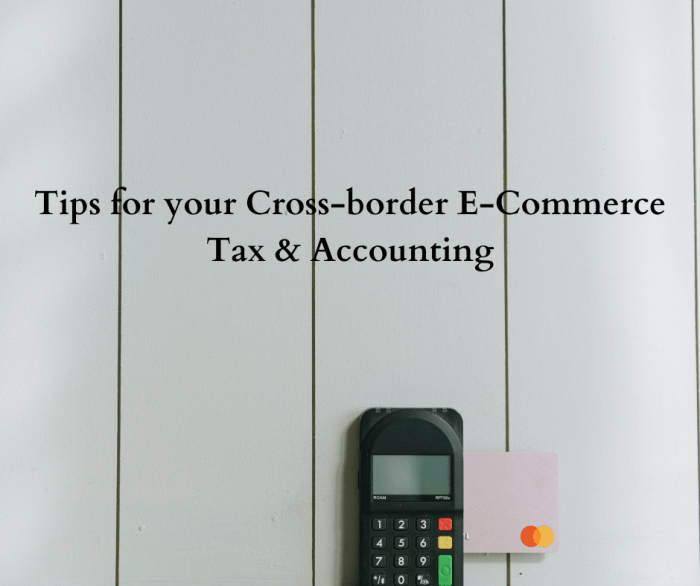Delving into the intricate world of cross-border ecommerce tax rules, this guide sheds light on the essential information businesses and consumers need to navigate smoothly through the complexities of international taxation. From understanding tax obligations to exploring the impact on consumer behavior, this overview provides a comprehensive look at the key aspects of cross-border ecommerce tax rules.
Exploring the nuances of tax regulations across different countries and the challenges faced by businesses in compliance, this guide aims to equip readers with the knowledge needed to thrive in the global marketplace.
Overview of Cross-border Ecommerce Tax Rules
Cross-border ecommerce tax rules refer to the regulations and policies set by different countries regarding the taxation of goods and services bought and sold online across borders. These rules determine the amount of tax that businesses and consumers need to pay when engaging in cross-border online transactions.
Examples of Countries with Different Tax Regulations
- United States: The U.S. has varying state tax rates and regulations, impacting online purchases made from different states.
- European Union: The EU has VAT rules that apply to goods and services sold online within the EU, as well as for imports from non-EU countries.
- China: China has its own tax regulations for cross-border ecommerce, including customs duties and import taxes.
Importance of Understanding Cross-border Ecommerce Tax Rules
It is essential for businesses and consumers to understand these rules to ensure compliance and avoid any legal issues or penalties. By knowing the tax regulations of different countries, businesses can accurately calculate taxes, determine pricing strategies, and plan for any additional costs associated with cross-border ecommerce transactions.
Consumers also benefit from understanding tax rules as it helps them make informed purchasing decisions and avoid unexpected tax charges.
Common Tax Obligations for Cross-border Ecommerce

In the realm of cross-border ecommerce, businesses encounter various tax obligations that can impact their operations and financial obligations. One key aspect to consider is Value Added Tax (VAT), which plays a crucial role in cross-border online sales.
Value Added Tax (VAT) in Cross-border Online Sales
Value Added Tax (VAT) is a consumption tax that is added to the price of goods and services at each stage of the supply chain. In the context of cross-border ecommerce, VAT applies to online sales made to customers in different countries.
Businesses are required to charge VAT based on the customer's location and the applicable tax rates in that particular jurisdiction.
For businesses engaged in cross-border ecommerce, complying with VAT regulations can be complex due to the varying tax rates, thresholds, and exemptions across different countries. Failure to properly account for VAT can result in penalties, fines, and reputational damage.
Challenges in Complying with Multiple Tax Jurisdictions
One of the major challenges for businesses in cross-border ecommerce is navigating the complexities of multiple tax jurisdictions. Each country has its own tax laws, regulations, and reporting requirements, making it difficult for businesses to stay compliant.
Moreover, keeping track of changes in tax rates, thresholds, and exemptions across various jurisdictions can be daunting. This can lead to errors in tax calculations, non-compliance with tax obligations, and potential legal consequences.
Impact of Cross-border Ecommerce Tax Rules on Consumers
The implementation of cross-border ecommerce tax rules can have a significant impact on consumers, affecting the final price they pay for goods purchased online. These rules may lead to changes in consumer behavior, influencing where they choose to shop and how much they are willing to spend.
Price Increase Due to Taxes
When cross-border ecommerce tax rules are enforced, consumers may end up paying higher prices for products due to additional taxes, customs duties, or import fees. These extra costs can make the final price less attractive, leading consumers to reconsider their purchasing decisions
Consumer Behavior Shifts
The tax implications of cross-border ecommerce can prompt consumers to shift their shopping habits. They may opt to purchase from domestic online retailers to avoid extra taxes or choose to buy fewer items to minimize costs. In some cases, consumers may even explore alternative sources or channels to find better deals.
Examples of Consumer Impact
- Scenario 1: A consumer in a country with high import taxes decides to buy a product from an international online store. Upon checkout, they realize the total cost, including taxes and shipping fees, is significantly higher than expected, leading them to abandon the purchase.
- Scenario 2: Another consumer finds out that a particular item they want to buy is subject to hefty customs duties when imported. As a result, they choose to look for a similar product from a local retailer to avoid the extra costs.
Strategies for Navigating Cross-border Ecommerce Tax Rules

When it comes to navigating cross-border ecommerce tax rules, businesses need to be well-informed and proactive in order to stay compliant with various tax regulations. Seeking the help of tax advisors or experts can greatly assist in understanding the complexities of cross-border tax rules and ensuring compliance.
Additionally, leveraging technology and automation can streamline the process of managing cross-border tax obligations efficiently.
Tips for Staying Compliant with Various Tax Regulations
- Stay updated on international tax laws and regulations that may impact your business.
- Maintain accurate records of all cross-border transactions and tax-related documents.
- Consult with tax advisors or experts to ensure proper compliance with tax obligations.
- Regularly review your tax strategies and make adjustments as needed to comply with changing regulations.
Role of Tax Advisors or Experts in Navigating Cross-border Tax Rules
Tax advisors or experts can provide valuable insights and guidance on navigating the complexities of cross-border tax rules, helping businesses to comply with regulations and avoid potential penalties.
Utilizing Technology and Automation for Managing Cross-border Tax Obligations
Technology and automation can play a key role in simplifying the management of cross-border tax obligations. By utilizing software solutions and tools designed for tax compliance, businesses can streamline processes, reduce errors, and ensure accuracy in reporting.
Last Point
In conclusion, grasping the intricacies of cross-border ecommerce tax rules is crucial for businesses looking to expand their reach across borders and for consumers seeking transparency in their online purchases. By staying informed and adopting effective strategies, businesses can navigate the complexities of international taxation with confidence and success.
FAQ Insights
How do cross-border ecommerce tax rules impact businesses?
Businesses may face challenges in complying with multiple tax jurisdictions, leading to complexities in reporting and fulfilling tax obligations.
What is the role of VAT in cross-border online sales?
VAT (Value Added Tax) is applied to cross-border online sales based on the location of the consumer, impacting the final price paid by consumers.
How can technology assist businesses in managing cross-border tax obligations?
Technology and automation can streamline tax compliance processes, helping businesses stay on top of their cross-border tax obligations efficiently.



